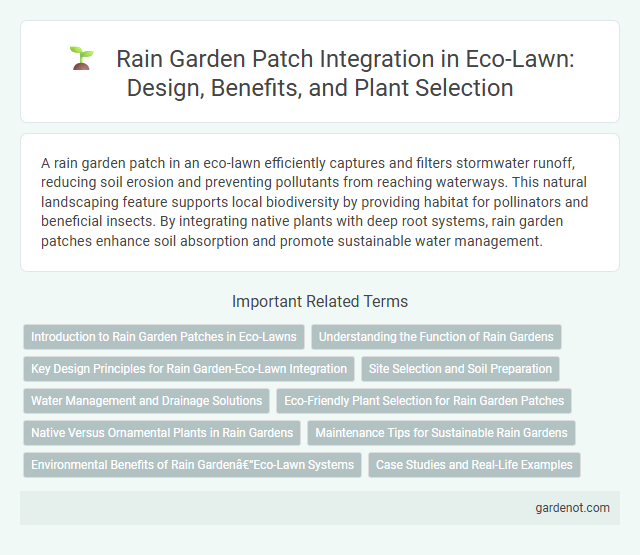A rain garden patch in an eco-lawn efficiently captures and filters stormwater runoff, reducing soil erosion and preventing pollutants from reaching waterways. This natural landscaping feature supports local biodiversity by providing habitat for pollinators and beneficial insects. By integrating native plants with deep root systems, rain garden patches enhance soil absorption and promote sustainable water management.
Introduction to Rain Garden Patches in Eco-Lawns
Rain garden patches in eco-lawns are specially designed depressions planted with native vegetation to capture and filter stormwater runoff, reducing erosion and improving water quality. These patches help manage rainwater sustainably by promoting infiltration and supporting local biodiversity through native plant species. Incorporating rain garden patches into eco-lawns enhances urban landscapes by mitigating flooding and reducing the need for conventional drainage systems.
Understanding the Function of Rain Gardens
Rain garden patches enhance eco-lawn sustainability by efficiently capturing and filtering stormwater runoff, reducing soil erosion and preventing pollutants from reaching local waterways. These gardens utilize native plants with deep root systems that improve soil absorption and promote groundwater recharge. Understanding their function highlights their role in managing urban water challenges and supporting biodiversity within eco-friendly landscapes.
Key Design Principles for Rain Garden-Eco-Lawn Integration
Rain garden patch design within an eco-lawn prioritizes native plant species with deep root systems to enhance stormwater infiltration and reduce runoff. Proper grading ensures water pooling in designated areas without impacting surrounding turf, maintaining lawn integrity and preventing erosion. Soil composition is optimized to balance permeability and nutrient retention, supporting both rain garden vegetation and sustainable lawn health.
Site Selection and Soil Preparation
Selecting a rain garden patch requires assessing site topography to ensure proper water capture and drainage, ideally locating it where runoff naturally accumulates. Soil preparation involves testing for permeability and amending with organic matter to improve infiltration while preventing waterlogging. Incorporating native plants suited to the site's moisture conditions enhances ecosystem benefits and promotes sustainable rainwater management.
Water Management and Drainage Solutions
Rain garden patches enhance eco-lawn water management by capturing and filtering stormwater runoff, reducing surface drainage and promoting groundwater recharge. These vegetated areas utilize deep-rooted native plants to improve soil infiltration, preventing erosion and minimizing flooding risks. Integrating rain gardens into landscape design supports sustainable drainage solutions that balance water conservation and ecosystem health.
Eco-Friendly Plant Selection for Rain Garden Patches
Eco-friendly plant selection for rain garden patches emphasizes native species that effectively absorb and filter stormwater, reducing runoff and improving soil health. Deep-rooted perennials like sedges, rushes, and wildflowers enhance water infiltration while providing habitat for pollinators and local wildlife. Choosing drought-tolerant and low-maintenance plants supports sustainable landscaping by minimizing the need for fertilizers, pesticides, and irrigation.
Native Versus Ornamental Plants in Rain Gardens
Rain garden patches benefit significantly from incorporating native plants, which are adapted to local soil and climate conditions, promoting better water absorption and supporting regional biodiversity. Ornamental plants, while visually appealing, often require more maintenance and may not provide the same ecological advantages, such as habitat for native pollinators and resilience to drought. Selecting native species like blue flag iris, switchgrass, and coneflower enhances a rain garden's sustainability and effectiveness in managing stormwater runoff.
Maintenance Tips for Sustainable Rain Gardens
Maintaining a rain garden patch involves regular weeding and mulching to preserve soil health and prevent erosion, which supports sustainable water absorption. Selecting native, drought-resistant plants reduces the need for frequent watering and chemical inputs, enhancing the eco-lawn's resilience. Inspecting the garden after heavy rains ensures proper drainage and prevents standing water, promoting long-term sustainability.
Environmental Benefits of Rain Garden–Eco-Lawn Systems
Rain garden patch integrated into Eco-Lawn systems significantly enhances stormwater management by absorbing and filtering runoff, reducing pollutant loads in local waterways. Native plants in these rain gardens improve soil infiltration and provide critical habitats for pollinators, promoting biodiversity in urban landscapes. This sustainable landscaping approach mitigates flooding risks while supporting groundwater recharge and improving overall ecosystem health.
Case Studies and Real-Life Examples
Rain garden patches effectively manage stormwater runoff by filtering pollutants and improving groundwater recharge, as demonstrated in numerous urban sustainability projects. Case studies from Seattle and Portland reveal significant reductions in surface water flooding and enhanced biodiversity within residential neighborhoods. Real-life examples highlight cost-effective installation and maintenance, making rain garden patches a practical solution for eco-lawn implementation.
Rain garden patch Infographic

 gardenot.com
gardenot.com